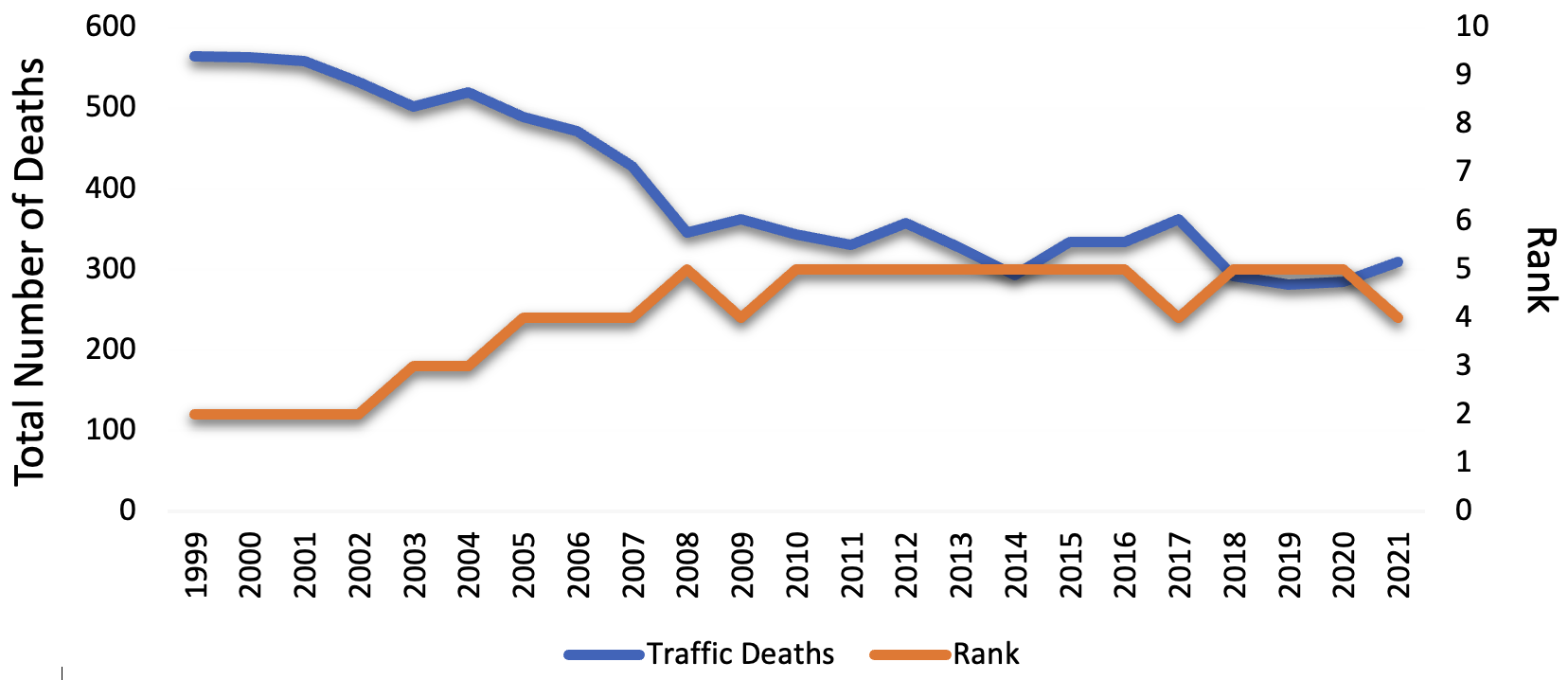In 2021, motor vehicle traffic crash deaths were the 15th leading cause of deaths overall in the United States. Among children, it has been one of the top 10 leading causes for over a decade. According to the National Highway Traffic Safety Administration (NHTSA), an average of 3 children were killed in traffic crashes daily in 2021; furthermore, traffic deaths among children increased by 8 percent from 2020 to 2021. To understand these grim statistics by age groups and race/ethnicity, I examined data from the Centers of Disease Control and Prevention’s (CDC) National Center for Health Statistics (NCHS) and found that the magnitude of traffic deaths intensifies.*
In 2021, there were 60.6 million children aged 14 and younger in the United States and motor vehicle traffic crashes is estimated to be the 6th leading cause of death. Furthermore, traffic deaths have increased among children; it was the 7th leading cause in 2019 and 2020, a one-point decrease in ranking compared to 2021. Examining the figures by five-year age groups reveals stark differences.

Moreover, motor vehicle traffic crash deaths have been among the top 10 leading cause of deaths for children these age groups since 1999, the earliest cause of death data set classified using the International Classification of Diseases 10th Revision (ICD 10) codes. (Motor vehicle traffic crashes were not among the 10 leading causes of death for infants <1 years old.). See the figures below.
Motor Vehicle Traffic Death Numbers and Rank of Motor Vehicle Traffic Crashes as a Cause of Death in the United States
Age group 1-4 years old, 1999-2021

Age group 5-9 years old, 1999-2021

Age group 10-14 years old, 1999-2021

Motor vehicle traffic crash deaths disproportionately affect children of color.

Note that for American Indian/Alaska Native children, the crude death rate per 100,000 population was flagged as “unreliable“.
According to NHTSA, child occupant traffic fatalities accounted for 80 percent of child traffic fatalities in 2021, a 3 percent increase from 2020 (77 percent). Occupants are defined as persons in “passenger cars and light trucks (pickups, SUVs, and vans) with gross vehicle weight ratings (GVWRs) of 10,000 pounds or less“. Though child safety seats are proven to be effective in reducing child traffic fatalities, improper or no restraint use continues to be an issue. In 2021, among passenger vehicle child occupants killed in fatal crashes, 40 percent were unrestrained. When looking at the variation of no restraint use by age groups, unrestrained fatalities were 34 percent for infants < 1 year old, a 7 percent increase from 2020 (27 percent). For children 1-4 years old, 30 percent were unrestrained while 42 percent of children 5-9 years old and 48 percent of children 10-14 years old were unrestrained in 2021. Moreover, restraint use among drivers influenced restraint use for child occupants killed in traffic crashes. According to NHTSA, ‘when drivers were restrained, 74 percent of child occupants were restrained. When drivers were unrestrained, 69 percent of child occupants were also unrestrained”.
Premature transition is a concern when children are secured with restraints that are improper for their weight, height, and age. NHTSA recommends to: “Keep your child rear-facing as long as possible. It’s the best way to keep him or her safe. Your child should remain in a rear-facing car seat until he or she reaches the top height or weight limit allowed by your car seat’s manufacturer. Once your child outgrows the rear-facing car seat, your child is ready to travel in a forward-facing car seat with a harness and tether”. According to 2021 National Survey of the Use of Booster Seats, an annual survey conducted by the NHTSA’s National Center for Statistics and Analysis, only 17.7 percent of children 1-3 years old were restrained in rear-facing seats while 69.1 percent were restrained in forward-facing car seats. Furthermore, an estimated 4.5 percent and 2.4 percent of children 1-3 years old were prematurely transitioned to booster seats and seat belts respectively. For children 4-7 years old, NHTSA recommends that the child is restrained in a forward-facing car seat per height and weight limit of car seat manufacturer, and transitioned to booster seats once the child outgrows the forward-facing car seat. The 2021 NHTSA NSUBS survey revealed that only 42.2 percent of children 4-7 years old were restrained in a forward-facing car seat while 31.0 percent were restrained in a booster seat. 16.1 percent of children 4-7 years old were prematurely transitioned to seat belts while 10.6 percent were unrestrained. For children 8-12 years old, NHTSA recommends that the child be restrained in a booster until the child is “tall enough to keep their backs against the seat and their feet flat on the floor“. Only 12.5 percent of children 8-12 years old were restrained in booster seats, 73.3 percent were restrained with seat belts, and 13.2 percent. were unrestrained.
There are solutions yet disparities in child safety policies and programs is an issue. According to the Governors Highway Safety Association, currently all U.S. States and territories have child passenger safety laws though requirements for these laws vary by age, height, and weight. “Nineteen states and the District of Columbia require that children younger than 2 years old to be restrained in a rear-facing child safety seat”. Many states require children to be restrained in “booster seats or other appropriate devices for children who are not the proper size for being restrained with a seat belt use”. Moreover, Child Passenger Safety Technicians (CPSTs), are people who are certified to provide free education on child passenger safety in their communities. The National Child Passenger Safety Technician (CPST) Certification Training was developed under the partnership of NHTSA, National Child Passenger Safety Board (NCPSB), and Safe Kids Worldwide. According to Safe Kids Worldwide, there are currently 36,249 technicians and 1745 instructors; with a population of 60.6 million children in 2021, there is a need to provide funding to train more Child Passenger Safety Technicians. Furthermore, state and local funding for Child Passenger Safety Training and child restraint inspection stations varies.
There is a dire need to protect children from the harms of motor vehicle traffic crashes. Though policy and program interventions have been implemented, this analysis reveals that gaps still exist which have resulted in fatal consequences among children in the United States.
* For the purpose of this analysis, motor vehicle traffic crash deaths were isolated from the category of “unintentional injury deaths’ and individually identified as a cause of death when ranking all other leading causes of death. To perform this methodology, CDC’s NCHS Mortality Data on CDC WONDER database was utilized to rank data by “Injury Mechanism & All Other Leading Causes”. Furthermore, NHTSA’s definition for children was used for this report; according to NHTSA, “children are defined as 14 years old and younger”.


















